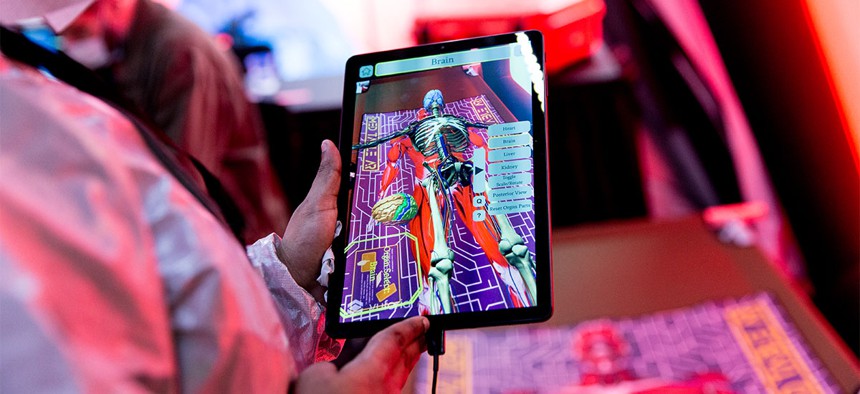sponsor content What's this?
Ecosystem of Tech Powers Emergency Responders in Real Time at Operation Convergent Response

First responders in hazmat suits show how technology can streamline emergency communications and management during an "Airport in Crisis" event at Operation Convergent Response in Perry, Georgia on November 20. Verizon
Presented by
Verizon

During Operation Convergent Response 2019, technology takes center stage as AI and telehealth tools demonstrate emergency response and communications in a decontamination simulation.
When disaster strikes, every second counts, especially in a potential pandemic involving a radiological, chemical or biological threat.
The 2019 Operation Convergent Response (OCR) conference in Perry, Georgia, showcased an ecosystem of technology that can help first responders assess and mitigate a potential crisis. Verizon, Nokia and an array of technology providers participated together in a simulated scenario of a flight gone wrong, demonstrating how first responders can effectively and efficiently manage disasters with the right technologies. To begin the scenario, a passenger on a flight starts experiencing symptoms of illnesses. Within minutes, more passengers report feeling sick, some with serious symptoms. The pilot springs into action and diverts the plane to a local airfield.
On the ground, a team of first responders knows from communicating with the pilot that a group of passengers are experiencing symptoms of unknown contagion. They deploy an emergency containment tent to isolate a potential outbreak. Wearing hazmat gear and body cams, these first responders make use of mobile devices to scan each passenger and identify any radiological, biological or chemical contaminants.
Technology is part of every stage of assessment and decontamination, and plays a powerful role in properly diagnosing and treating each person quickly and efficiently.
Cinematic video capture provides 4D visualization of each person and then relays those images back to a joint operations center (JOC), where other experts can offer additional support and information to first responders on the ground. The command post also has the ability to pull up weather scenarios, flight patterns and flight traffic to assess whether the plane’s path could have impacted passengers. It allows first responders and pilots to communicate and access visualizations in real time, explained Jason Mitchell, Verizon Response Team and LMR interoperability manager.
“We have all these sensors pointing back to the common operating picture and we are using that technology to set up a makeshift air traffic control,” he said.
AI, Virtual Medicine and Telehealth Offer Quick Assessments
AI-driven technology detects and mitigates risks, such as when a passenger has been exposed to radiation. AI-powered software performs a second scan that can help identify the isotope causing the alarm and assess whether it’s a nuclear issue.
In the case of one patient, the AI software scans a flu pill he is taking, analyzing its contents and discovering that it is counterfeit. Ultimately, the technology allows the care team to help the patient to get the necessary care.
In the case of a patient with elevated vitals sent to triage, a first responder taps telehealth technology in order to quickly share the patient’s history, vitals and photos of impacted areas with an off-site health provider in real time. The physician assesses the vitals and can help coach the first responder via audio and video feeds, drastically reducing the amount of time it takes to accurately treat the patient.
“We wanted to highlight the opportunity we have here with virtual medicine running in a disaster scenario. It’s super important that we’re bringing care to the patient. And on Verizon’s network, with the ability to drop right in, I can bring experts in from anywhere else on the planet. Geography no longer dictates my care solution,” said Cathy Lester, Verizon’s health transformation leader. Lester, a certified EMT and certified public health professional (CPH) by the National Board of Public Health Examiners (NBPHE) by NBPHE also has a master of engineering in telecommunications and is a trained emergency health planner.
Technology Empowers Intra-Agency Collaboration
In a crisis like this, technology offers opportunities to relay incident data and information to supporting and responding federal agencies, such as the Federal Emergency Management Agency (FEMA) and the Centers for Disease Control and Prevention (CDC).
It’s all about working together as an ecosystem to figure out how to solve a problem, said Lester
Ultimately, OCR helps Verizon deploy solutions that can offer first responders, agencies and providers a common operating picture in order to simplify decision-making and care in emergency situations.
“Because in the end, when it matters, it’s about people and it’s about the right technology,” Lester said.
Learn more about how first responders tapped tech at OCR 2019 to tackle wildfires and cyber attacks.
This content is made possible by our sponsor. The editorial staff was not involved in its preparation.
NEXT STORY: Technology Fuels Efforts to Quell Wildfires at OCR 2019





